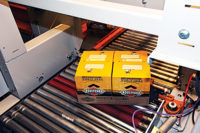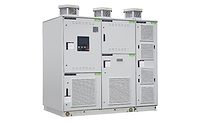The happy, hybrid palletizer medium
Robotic, conventional palletizers offer differing benefits

Columbia Machine offers its hybrid FL3000-R floor-level palletizer, which can operate at speeds greater than 80 cases a minute, depending on pack pattern, it says. (Image courtesy of Columbia Machine Inc.)
“The introduction of a robotic palletizer has had a huge impact on our business,” say Product Manager Jason Covington and Business Development Manager Steve Golladay of ITW Warehouse Automation (ITWWA), Arden, N.C. “We now can handle a wider variety of cases more effectively; we are able to create more stable pallets, even as our customers have moved to more lightweight packaging.”
As packaging styles continue to develop, robotic palletizing solutions are agile enough to accommodate new package shapes and sizes, according to the ITWWA duo. Plus, the dynamic capabilities of such systems allow manufacturers to build multiple complex packages on the same pallets on the fly by accessing case-picking software through the human-machine interface, they say.
In addition, robotic palletizers often offer gentle handling of lightweight packages compared with more traditional methods, says Matt Job, business unit manager of automation for Greenville, S.C.-based Hartness International Inc. Traditional bump-turn palletizers apply blunt force to a product that lighter-weight packages might be unable to sustain, he says. Robotics can offer a gentler handling alternative, he notes. “The robot itself is acting as both the laning device and the turning device, and it’s gripping the case with servo-based torque technology, so basically we’re eliminating the torque,” he explains. “So now you have a smart control system to capture the case and turn it and lane it, versus a traditional method of bump-turning … where a lot of force is being put on the case through mechanical force; now we’re using servo-based technology to control that force.”
Along with this handling flexibility, robotic palletizers offer high reliability in production, says Terry Zarnowski, director of sales and marketing for Schneider Packaging Equipment Co. Inc., Brewerton, N.Y. For example, a robot can perform more than 80,000 hours mean time between failures, he says.
Plus, considering that robots have decreased in price and increased in speed, these palletizing solutions can prove to be a better fit for many applications, notes Earl Wohlrab, palletizing and robotics systems product manager for Intelligrated, Mason, Ohio.
However, there still are some applications where conventional palletizing is a beneficial option, according to a 2011 Intelligrated white paper titled “Conventional vs. Robotic Palletizing.” For example, inline, continuous-motion palletizers are useful for high-speed applications at speeds of up to 200 cases a minute and 20 layers a minute, which would require the work of multiple robots working together to achieve such speeds, it states.
Conventional palletizers also can be useful when working with reduced product packaging, according to Intelligrated’s white paper.
In addition, conventional palletizers offer increased flexibility in handling changing and complex pallet patterns, the white paper states. Because conventional palletizers handle cases individually, pattern changes have a relatively small impact rate on production, it adds.
The white paper concludes that hybrid applications can serve as a compromise to blend “the flexibility and repeatability of robotic arms with the speed and reliability of the conventional palletizer.” In line with this, Intelligrated offers its Alvey 951 hybrid palletizer, which combines a conventional palletizer with a robotic arm to provide greater flexibility and gentler product handling, it says.
Columbia Machine Inc., Vancouver, Wash., also offers its hybrid FL3000-R floor-level palletizer. This system can operate at more than 80 cases a minute, depending on pack pattern, the company says.
Once beverage-makers are ready to operate with their robotic, conventional or hybrid palletizers, they can choose to incorporate different features and accessories into their production lines for added efficiency, experts note.
Manufacturers are designing machines with specific features to ensure smooth handling for new containers such as reverse taper glass bottles, according to Bryan Sinicrope, vice president of sales and marketing for A-B-C Packaging Machine Corp. For optimum depalletizing of these bottle styles, the Tarpon Springs, Fla.-based company uses proprietary handling techniques to ensure stability during the process, he says.
Currie by Brenton, a division of Loveland, Ohio-based Pro Mach Inc., provides a corner board placer solution for palletizers that works in conjunction with an Orion stretch wrapper to better handle and protect pallets of lightweight packages, says Jason Bennett, palletizer product line manager. After the load is palletized, robots attach corner boards to the four corners of the pallet, he explains. The process is completed when the load is stretch wrapped, increasing stacking strength and allowing for double stacking for a more efficient pallet, he adds.
Looking for a reprint of this article?
From high-res PDFs to custom plaques, order your copy today!







